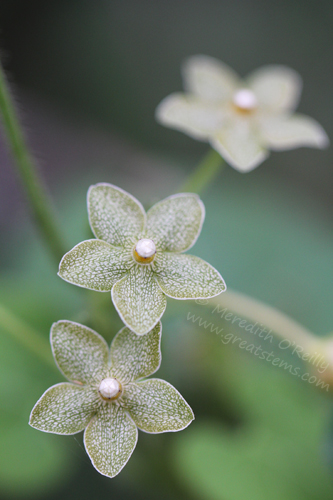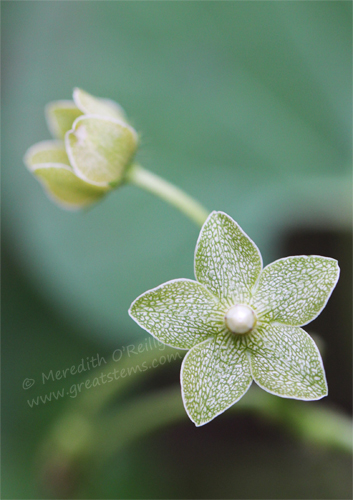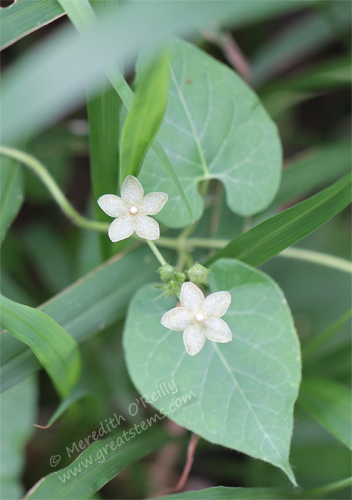Once again, nature has brought me a gift — one of my favorite vines, and one that I’ve only ever seen in the wild. So I guess it’s fitting that I found it in the wild portion of my yard. Thank you, wind or mammal, whichever of you that brought this seed to my garden!

This lovely plant is called Green Milkweed Vine (Matelea reticulata) by some, but I prefer to call it by its other common name, Pearl Milkweed Vine. That shiny little center spot looks too much like a pearl to not include it in the name.
The vine will, in fact, ooze a milky sap if a leaf is broken off. If you are wondering whether it is a Monarch/Queen host plant, given that it is a Milkweed, some online sources indicate that it is indeed one, albeit a minor food source for them, perhaps. Personally, I haven’t yet seen a caterpillar on it.

This vine is more dainty than bold, and it’s easy to pass right by it when walking in the woods. But once you catch a glimpse of its shiny little pearls, it’s mesmerizing. Mine is currently twined around a bunch grass — and annoyingly, some hackberry sprouts — but it’s growing well. I haven’t actually found the base of the vine yet — I’m so protective of it that I barely want to mess with the tangle.
The leaves of the Pearl Milkweed Vine are heart-shaped, and when it’s time to go to seed, this dainty vine will actually produce a whopper of a seed pod, much like its Milkweed cousins. Inside will be many seeds with silky fibers to aid in dispersal. I can’t wait!
I’ve never seen or even heard of that plant! I’m glad you introduced me to it. I’ll be looking for it now, but it’s a Texas native? Where else might it be found? Love the heart shaped leaves and the pearls.
Daricia, it is definitely native to Texas. I’ve never seen it for sale anywhere, but I’ve seen it on several hikes in the Austin area, both in bright sun and in shade. It is such a gorgeous vine. Look up Star Milkweed Vine, too — that’s another beautiful favorite, though I haven’t been lucky enough to find it in my yard yet.
I found this vine growing wild in my yard. I live in the Hill Country. I have seen a Queen chrysalis on it. I have some seeds. Do you know how to grow them?
I haven’t tried to grow it personally. I would imagine it is fairly similar to the growing methods for other milkweed and likely has mixed success, just as those plants have. I suspect that planting in the fall and letting the seeds experience the cold season might help them.
Love those first two photos! What a unique and wonderful little bloom!
It’s such a sweet plant, Alan — I love, love, love it.
Wonderful post which brought back memories of my first encounter. I usually took my first cup of coffee and wandered around my daughter’s property in Dripping Springs, Texas. One morning I found this little jewel blooming and went back inside and looked it up. Only a few of us get to enjoy it in its native habitat. Thickets on rocky hillsides; found in Bell, Burnet, Palo Pinto, and Parker counties, as well as Brown, Comanche, Eastland, and Johnson counties. Central, south and west Texas are the only places listed where it’s been found.
I’ve been lucky enough to run across it just a handful of times, Marilyn, mostly in wooded areas but once in brighter sun. I was going to say that I’m impressed at your memory of your first encounter, but then I realized that I remember mine, too! I’ve seen it in Travis, Hays, and Williamson County here.
A fellow blogger recently found this plant in her garden too. She shared some seeds with me. Any planting advice?
I wish I knew what to tell you, Ally. I didn’t plant mine, so I don’t know what made the perfect conditions. Other milkweeds can be a challenge to get going (easy to germinate, hard to grow), but I have another milkweed vine (not the pearl) that is popping up all over the place. I just don’t know whether Pearl Milkweed would be on the easier side or the harder side. I can tell you that mine is growing in very dappled light — more on the shady side. It has received no attention from me, and since it’s in the wild area, that means the soil isn’t “garden rich” but just organic, natural woodland soil. Perhaps try a variety of planting styles if you have enough seeds — plant in sun, plant in shade, plant in garden, plant in poorer soil, germinate first then transplant. Good luck! I’m hoping that some seeds will show up on this vine.
I’ve also never heard of this milkweed. I fully understand why you love it. But it is even more treasured because it is growing in your garden as a volunteer. So very cool! Thanks for sharing your beautiful photos!
I love volunteers — they often grow better than plants you purchase!
Such an enchanting, delicate, fairy-tale plant. After wishing hard for years, I saw my first one about a month ago, alongside the Turkey Pass trail at Enchanted Rock State Natural Area — ON MY BIRTHDAY!
What a sweet birthday present! Happy belated birthday!
Meredith:
Just spotted a Monarch laying 2 eggs on a Pearl milkweed vine. Very surprised given that I have 3 types of milkweed all over my yard specifically for the Monarchs. Picked the tiny plant beacuse I thought that the butterfly was confused (I was the confused one). Have never seen this before anb given the low numbers of monarchs I’ve seen so far this season, well this really caught my attention. Will place a photo of the egg on this plant on my blog very soon. Thanks for helping me to identify this additional food source for Monarchs.
Excellent, Daniel! If you still have the plant and eggs, I hope that you can capture photos of the caterpillars eating the vine — I would love to see that and know it truly is a good host plant. It surprises me, too, that the monarch chose the vine over the other types of milkweed, but perhaps it depends on the type you have. I know that A. tuberosa is NOT a preferred choice, as it doesn’t have the toxicity they need for protection.
Meredith,
we seem to have an abundant supply of this plant in our garden, wild growers, more on the shade side like you mentioned…. I was searching for the name forever. Thank you!!!! Queens and / or soldiers regularly ovideposit on it. I collected some seeds when the – indeed whooopppper – pods opened in Dec 2014 here. Did yours ever grow and reseed? Did you ever grow it from seeds?
Cuttings don’t seem to work as well with me as it does with my curassavia…
Hope you enjoy plenty of these precious plants by now!
Best,
S
Sandy, I’m glad to know that butterflies do visit the vine. My vine continues to stay small, so I haven’t tried yet to grow it from seed or cuttings. Hopefully this year will be year!
I hiked along the Frio River in Real and Uvalde Counties this week. This milkweed was growing everywhere. It is so tiny that it is easy to miss (and especially with more vivid wildflowers continuing their show). I first saw it last year and now search for it.
Lovely that you saw so much of it, Amy! It is one of my very favorite plants.
Meredith, we have just come across the Pearl milkweed vine in the wild and my children spied several monarch caterpillars on them of varying sizes. Three of the four caterpillars were Queens. I even noticed what I think are 2 egg sacs under one leaf. It really is a beautiful flower. I was wondering about the toxicity for the butterflies’ protection.
I’m so excited to hear that you have seen caterpillars on the Pearl Milkweed Vine! I don’t know the level of toxins in the sap, but I’m sure the caterpillars were still benefitting from their markings and the fact that other milkweed does create that bad taste to convince predators to stay away.
I got one at the Ladybird Johnson Wildflower Center spring plant sale last year. It’s growing on my fence in my front yard.
I hope you have already had some beautiful flowers! I do know that the Wildflower Center mistakenly sold another species as Pearl –hopefully you got the real thing. If your plant has hairy stems, chances are you did.